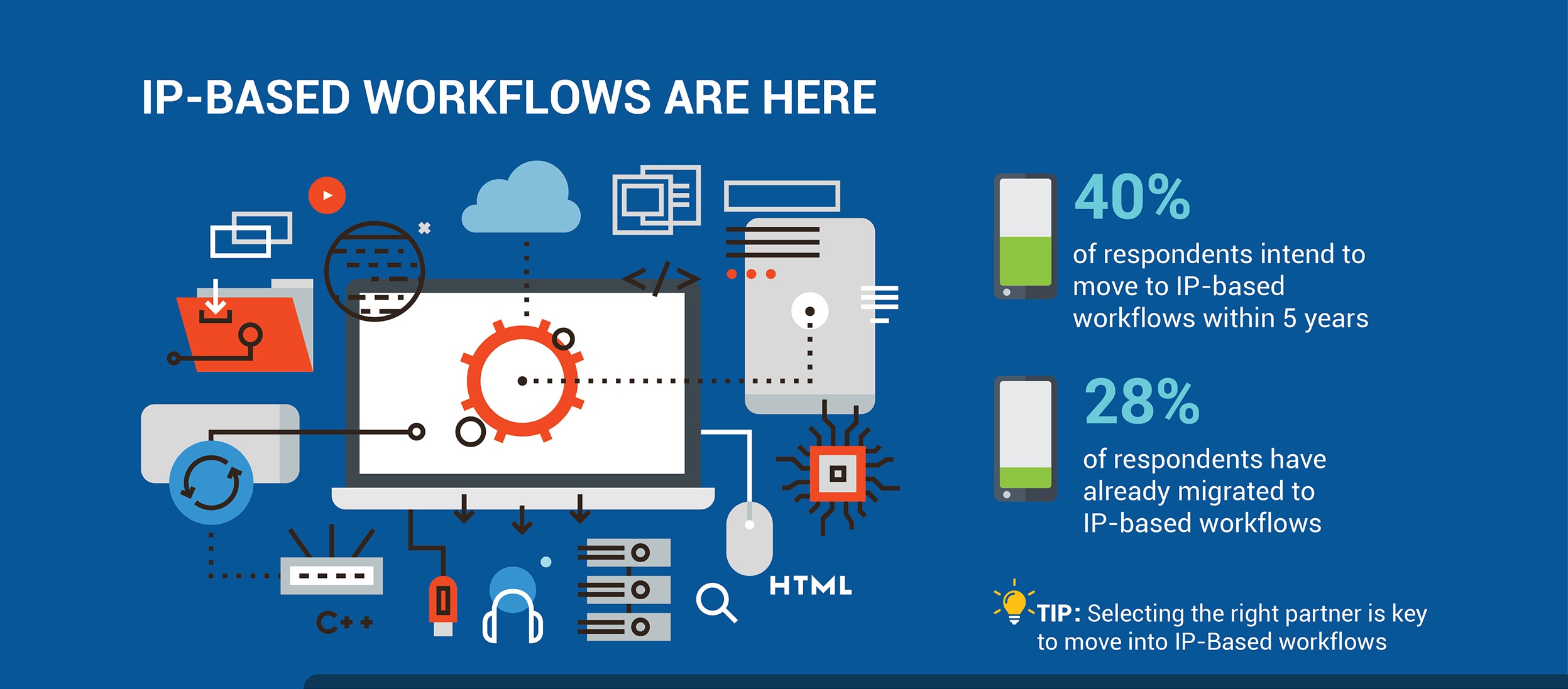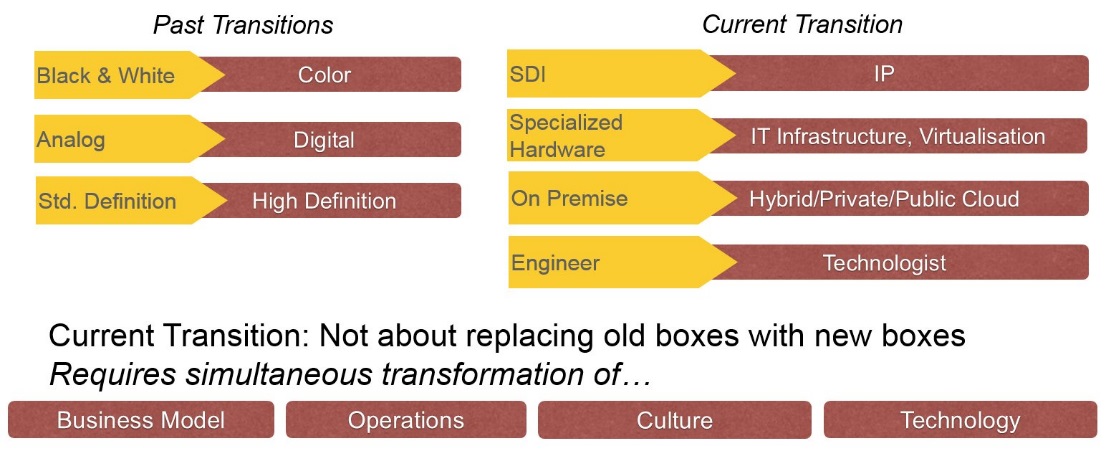Media Workflow Trends Survey- Industry Transformation is Underway
Earlier in 2016, Dell EMC commissioned Gatepoint Research to conduct an extensive survey with Media Industry executives. The survey, entitled Media Workflow Trends yielded some interesting results that point to a good understanding of the pace of change, and the need to stay agile for competitive advantage.
The results of that survey are summarised in a new Infographic, which apart from being much more interesting than a series of pie charts brings to the surface the key themes that align with the technology development strategy of Dell EMC.
Content Storage Demands Are Exploding
I have worked in the media industry for decades, and so this is hardly a surprising finding. Early in my career, it was commonplace to find production offices full of shelves and compactus storage units. These were crammed with videotapes. Then there were boxes stacked everywhere – also full of tapes with titles scrawled on the back. There were colour-coded stickers – “Master”, “Protection Master”, “Edit Copy”, “HOLD”… There was a warehouse full of tapes of various types, even old films. One thing you learned, is that nothing was ever thrown away (but plenty of things went missing).
Fast-forward to 2016, and most media companies involved in production and distribution of content have shifted to file-based Media Asset Management systems – or at least a media content archive repository. This has helped to contain the data sprawl into a central location, but it has done nothing to reduce the total storage capacity requirement. Think about the increasing resolution of content, the increasing number of channels, multiple versions for different delivery platforms and of course the increasing “shoot to use” ratio. Sports events have increasing number of cameras with retained ISO recordings for highlights and post-match inquiries, Reality TV formats are based on multi-cam techniques to get every reaction from different angles. Whilst these programs are in production, the storage capacity demands can skyrocket.
Only 3% of our survey respondents replied that storage needs are flat or negative – and 50% responded that the demand for storage capacity is growing rapidly and a major concern.
Multiplatform Content Delivery
Pretty much every major media company is either doing this already, or has a plan to extend their audience reach beyond simple linear broadcast channels in the next few years. But what is interesting is the increasingly careful way in which media companies are deploying their solutions.
Recognising that the simple approach of outsourcing multiplatform content delivery to a third-party OVP (Online Video Platform) is not very revenue accretive, Media companies are now starting to embrace DIY in order to pull-back some profit margin in what is otherwise a very difficult to monetise delivery strategy. As we learn more from some of the leaders in this industry – such as MLBAM – we can see the benefits in taking control and managing as much of the content delivery process end to end. Just like we always did with linear content delivery over terrestrial RF transmitters, satellite transponders and cable TV networks.
One of the key tips is being ready to scale. As streaming demand spikes and grows with popular content, how can every incremental viewer bring incremental profit – not just rising CDN costs? Taking a tip from Netflix, you can build a distributed origin and control the CDN deeper into the delivery network. Dell EMC has repeatedly partnered with some of the leading solution vendors in this space, who make it easier to deploy a well-managed and profitable multiplatform content delivery system.
IP-Based Workflows are here
Most industry commentators seem to get pretty excited about “the death of SDI”, and how soon IP networking can completely replace the dedicated video & audio circuits of the past. But really, that is just a side show for which we will soon lose interest. There is no “right or wrong” way to build a media facility. The engineers and technical architects will select the appropriate technology on a case by case basis as they always have, based on reliability, quality, cost, ease of management etc. And over time, there will simply be more connections made using IP network technology and fewer using dedicated single-purpose technology.
But what is the end-game? I see it as moving our media equipment technology stacks (also known as the “rack room” or “central technical facility”) away from dedicated single-purpose vendor solutions built and managed carefully by Broadcast Engineers into a flexible virtualised technology stack that looks identical to a cloud-scale data centre – built and managed by IT and Media Technologists. It will be open architecture, built on software-defined principles and capable of easy repurposing as the application technology needs of the business shift more frequently than they did in the past.
It is important to select your partners carefully as you make this transition into IP and software-defined. Dell EMC has deliberately remained vendor neutral and standards-based. We have aligned with SMPTE and AIMS who we believe are two organisations that have the broad interests of the industry (both end-users and vendors) at heart, and will result in practical, cost-effective and widely-adopted solutions.
As a pioneer and leader in scale-out storage, virtualisation and converged infrastructure, Dell EMC is in a great position to help you avoid costly mistakes during your transition to IP-based workflows.
Click to see the full M&E trends infographic
Ultra-HD Is Coming
Well, it’s already here. Of course most people shopping for a new flat screen TV today will see that their options include 4K resolution, and are increasingly affordable when compared to the default HD TV resolution. Some in the industry will say that 4K is unnecessary and is being pushed by the consumer electronics manufacturers – but when has that ever been a different story in the past? There is no doubt that consumers appreciate improved quality of content, and story-tellers love the creative opportunities afforded by the latest technology. When we can finally deliver ALL of the aspects of Ultra-HD, such as HDR (high dynamic range), HFR (high frame rates) and multi-channel surround sound that will be one step closer to reality.
At the SMPTE Future of Cinema Keynote during NAB 2016, pioneering movie Director Ang Lee said;
“Technology must work for us to help tell the human story. Whether it is from 2K to 4K, or 24 to 60fps, it improves the sensory experience and as a viewer, you become more relaxed and less judgmental. We will always be chasing god’s work – which is the natural vision and sensory experience. We are getting closer and learning more about how we communicate with each other.”
In the world of content creation and media distribution, we will increasingly adopt 4K cameras, render graphics and animations at increased resolution and ensure the product we make has an increased shelf life. This is natural, even if it is happening before we have an ability to deliver this content to our viewers. And while it is difficult to “rip and replace” cable, satellite and terrestrial networks that are still only shifting from SD to HD with new 4K solutions, OTT content delivery using internet broadband and mobile networks will probably be the way most consumers first access Ultra-HD.
Dell EMC Isilon is a scale-out storage solution that grows in capacity and bandwidth as more nodes combine into a single-volume multi-tier cluster. We already have numerous customers using Isilon for 4K editing and broadcast today. As we constantly innovate and bring new technology to market, we continue to deliver to our customers the benefits of Moore’s Law. The real key to Isilon technology is the way that we deliver platform innovation in an incremental and backward-compatible way – supporting the ability to scale and grow non-disruptively.
Beyond LTO Archiving
I mentioned earlier in this blog how my early career was defined by shelves and boxes of tapes – videotapes everywhere. I spent time in my day handling tape, winding tape into cartridges, even editing audio and videotape using a razor blade! The most important machine in the building (a commercial TV station) was the cart machine. That was because it held all of the commercial 30 second spots, and if those did not play, the TV station did not make money and we would not get paid.
Finally we replaced cart machines and replay videotape machines with hard disk servers that were highly reliable, fast to respond to late changes and very flexible. So I wonder when we will say it is time to replace the data tape archive library with a cloud store? Certainly we are all familiar with and probably daily users of one of the biggest media archives in the world (I refer to Google’s YouTube). Wouldn’t it be great if your company had its own YouTube? A content repository that was always online, instantly searchable, growing with fresh material and just as easy to use?
So then we get down to cost. It turns out, that even though they seem cheap, the cost of actually using a public cloud store for long term retention is a lot more expensive than existing data tape technology – especially as the LTO industry brings innovation beyond LTO-6 into the latest LTO-7 data tape format with 6TB native capacity.
But that migration process to move all of your media from one standard to the next is painful and time-consuming – introducing cost, wear & tear and impacting on end-user search & retrieval times from the library.
From our survey respondents, the top features for consideration of a storage solution are performance, scalable capacity and efficient use of resources (floor space, power, personnel). So if we took those criteria into account, cloud storage should win hands-down – if only the price was right.
Well finally now it is. Dell EMC has been developing an innovative product called ECS (Elastic Cloud Storage) which meets all of the requirements of a Modern Archive – scalable, multi-site geo-replication, open architecture, software-defined. And now it is available in a range of hardware platforms that offer the high packing density of large capacity and very efficient hard drives – today 8TB is supported and clearly that native capacity will grow.
Increasingly customers are asking us whether this technology is price competitive with LTO libraries, and whether it is reliable and ready for mission-critical high-value archives. The answer to both of these questions is yes, and the benefits of moving to your own cloud store are significant (whether you choose to deploy it within your own premises or have it hosted for you).
Cloud Solutions are gathering converts
When you boil it all down, our industry is in transformation from a legacy & bespoke architecture to that of a cloud. The great thing about a cloud, is that it is flexible and can easily change shape, scale and take on new processes and workloads. And it doesn’t have to be the public cloud. It can be “your cloud”. Or it can be a mix of both – which really gives you the best of both worlds. Public cloud for burst, private cloud for base load and deterministic performance.
Building clouds and bringing technology innovation to industry is what Dell EMC is really good at. Speak with us to learn more about how to embark on this journey and the choices available to you.
SUMMARY
So we find that across the media industry the evolution is underway. This is a multi-faceted transformation. We are not just switching from “SD to HD”, we are actually evolving at the business, operations, culture and technology level.
Dell EMC is positioned as an open architecture vendor neutral infrastructure provider offering best in class storage, servers, networking, workstations, virtualisation and cloud management solutions. Engage with us to secure your infrastructure foundation, to be future-ready, and to simplify your technology environment so that you can focus on what really matters to your business – what makes your offering attractive to viewers (on any platform)

